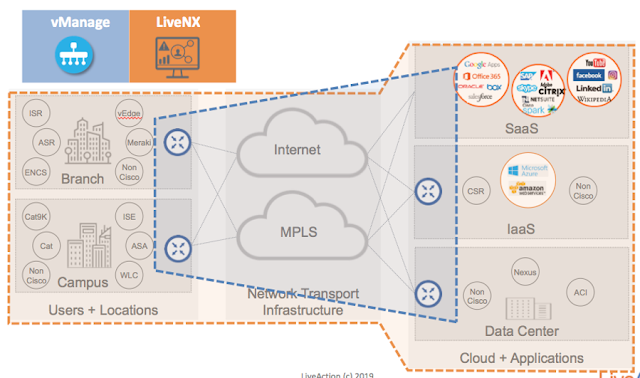Cisco and LiveAction have been jointly innovating for years, ultimately with the objective of helping our mutual customers deliver better user experiences, while simplifying network performance management and troubleshooting. Today, LiveNX is deeply integrated into Cisco SD-WAN; Cisco DNA Center; and most Cisco routers, switches, and firewalls. LiveNX provides unified network monitoring across Cisco network environments such as Cisco Webex, hybrid cloud, and multidomain monitoring. (See Figure 1.)
Figure 1 – A typical enterprise SD-WAN environment
As enterprises continue to migrate to Cisco SD-WAN to control and direct traffic over their wide area networks, many are turning to LiveNX to gain insights into performance, QoS policies, path routing, and traffic management complexities. These insights allow them to optimize Cisco SD-WAN, other Cisco infrastructure, and even extend visibility into multivendor network environments.
In addition, with Cisco SD-WAN now supported by Cisco IOS XE router software—enabling a large installed base of Cisco ISR, ASR and ENCS devices to deliver on Cisco SD-WAN benefits—LiveNX now offers visibility into an even broader range of devices. And LiveNX is the only Network Performance Monitoring and Diagnostic (NPMD) platform to support migration to the Cisco cEdge.
Speaking tactically, enterprises can begin to realize the benefit of the Cisco and LiveAction collaboration throughout the SD-WAN journey:
◉ Day 0—Plan: Select pilot sites when planning SD-WAN deployments, identify unsanctioned applications and end users, and establish network utilization baselines to be used for rightsizing.
◉ Day 1—Verify: Use LiveNX real-time visualization to verify SD-WAN policies and prevent services from being impacted by brownouts or other abnormal events.
◉ Day 2—Operate: Monitor bandwidth and visualize path control so network administrators can manage performance and address problems before they affect users. Use business application reporting to manage and optimize voice and video communications. Easily visualize issues and make repairs with the click of a mouse.
Webex performance monitoring
Cisco Webex is simple to use, but protecting voice and video call quality across the enterprise network can be challenging. To meet this challenge, network administrators can utilize LiveNX to monitor, troubleshoot, and provision Webex QoS, helping to ensure that bandwidth is properly allocated. For example, administrators can use LiveNX to go back in time—like a “network DVR”—to analyze and troubleshoot Webex calls and address VoIP call quality issues. In addition, LiveNX can easily protect critical Webex traffic across the managed network.
Hybrid cloud monitoring and more
As organizations migrate their workloads and applications to hybrid architectures utilizing AWS and Azure, LiveNX provides end-to-end visibility of all network traffic over the public cloud network. This capability includes support for AWS Virtual Private Cloud (VPC) and Azure Virtual Network (VNet) and delivers value in a number of use cases:
Cloud migration
◉ Baseline the current state of the data center network to create a migration plan.
◉ Track and display network traffic and job movement during migration.
◉ Understand, from the network perspective, what has changed in the data center post-migration.
Cost analysis
◉ Understand traffic flows to and from different cloud services, enabling more informed cost analysis and reducing the risk of budget surprises.
Operations
◉ Provide persistent monitoring of mixed hybrid and multicloud environments.
◉ Troubleshoot application and public cloud services.
Security analysis and incident response
◉ Identify inbound or outbound traffic being blocked by security group rules.
◉ Offer visibility into public cloud infrastructure from external sources by country.
◉ Enable search by service, IP, port, protocol, and location of security issues.
LiveNX monitoring goes beyond hybrid cloud, to include monitoring multivendor, multifabric, multicloud, and multitelemetry environments. In essence, it provides visibility across the most complicated enterprise networks. (See Figure 2.)
◉ Multivendor: 100+ vendors supported
◉ Multidomain: Campus, branch, data center, cloud, and WAN
◉ Multifabric: SD-Wan, SD – ACCESS, ACI
◉ Multitelemetry: SNMP, API, IPFIX, Netflow
Figure 2 LiveNX delivers multivendor, multifabric, and multicloud monitoring
The value of partnership
LiveAction is perhaps best known for visual analytics that simplify network management and enable faster troubleshooting. Cisco is well known as a market leader in networking. So it’s no surprise that the two companies have forged a partnership whose overall objective is to allow our mutual customers to optimize the value of their wide area networks.
Further validating the strength of this partnership, LiveNX is now available to Cisco sellers on the Cisco general price list.
If your success depends on the performance and security of your wide area network, take a look at how Cisco and LiveAction join innovations can support you.
























